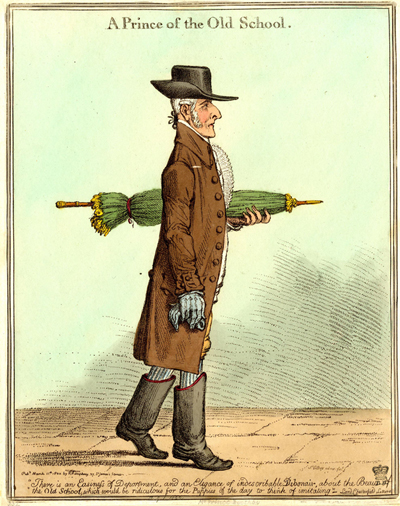A Prince of the Old School
A Prince of the Old School is a portrait caricature of an older, grey-haired gentleman with the wonderful name of Boothby Clopton. It is one of four full length single figure profile caricatures that Gillray created in 1800 with little to no verbal or graphic commentary. With their minimal satiric content, they appear almost a return to the Italian portrait caricature model, where the subject is regarded ironically but with little or no obvious satiric intent. But unlike Italian caricatures which were mostly flat, two dimensional line drawings, these are richly detailed and nuanced stipple portraits that taken together represent a new level of sophistication for portrait caricature.

© Trustees of the British Museum
In his younger days, Charles Boothby Clopton was "one of the greatest beaux in town" and his behavior and eccentricities were said to have formed the basis of the character of Prince Leveret in George Colman's The Separate Maintenance (1779). A contemporary review of that play in the Westminster Review describes Prince Leveret as
a true copy of a noted original, who, by way of eminence in the arts of Macaronism, is stiled the Prince of Coxcombs. The most essential business of this professional Macaroni being to debauch the wives of his friends. (Volume 7, p. 491)
Still popularly known in fashionable circles as "Prince,"' Boothby had been more recently distinguished, according to the Monthly Mirror (August 1st, 1800) by his "partiality for noble company" and a singularity of dress, which "resembled that of a quaker."
He never walked without an umbrella, either in summer or winter, and had not changed the shape of his hat for the last twenty years.
Gillray's portrayal of him in profile against a blank background serves to emphasize the stark horizontal of his hat and unbrella and his short, tip-toe, stride creates a corresponding sense of stiff verticality. His facial profile with its sharp nose and chin and eyes fixed directly in front of him create an impression of someone fixed in his ways and routines—old school indeed. Which makes the lines beneath his image identified as coming from the letters of that paragon of old school gentlemanliness, Lord Chesterfield, seem particularly apt.
There is an Easiness of Deportment, and an Elegance of indescribable Debonair about the Beaus of the Old School which would be ridiculous for the Puppies of the day to think of imitating.
But in fact the caption does NOT come from Chesterfield's famous Letters at all. It is rather a clever imitation of Chesterfield's style—most likely by Gillray himself who had a history of creating plausible quotations for his prints. See, for instance, The Republican Rattle-Snake Fascinating the Bedford-Squirrel (1795) where he imitated entries in Pliny's Natural History and A Sphere Projecting against a Plane (1792) where he channels Euclid's geometric definitions. If satiric at all, the caption is of the mildest variety, and serves more to confirm the identification of this old school gentleman with "'Prince" Boothby who was between 50 and 60 at the time.
Gillray indicates that his portrait was taken from the life (Js Gillray ad viv : fect). which usually means that it is based on a sketch he made on a small card. He certainly would have had ample opportunity to make that kind of sketch. Boothby lived on Clarges Street, a seven minute walk from Hannah Humphrey's shop at 27 St James's Street. If his sketch was done in preparation for the print, it would have been approximately three months before Boothby's suicide. The British Museum, following Wright and Evans, suggests that he shot himself "after having wasted a large fortune." But the most extensive account of his last days in the Monthly Mirror (August 1, 1800) mentions a number of possible causes, including one that Gillray would have been suprised by:
Various causes are assigned for his derangement, and, amongst others, it is said he lost a large sum at play; that a law-suit affected his mind, that his feelings had been hurt by a caricature; and that he had been duped by informers.
Sources and Reading
- Commentary from the British Museum on A Prince of the Old School.
- Thomas Wright and R.H. Evans, Historical and Descriptive Account of the Caricatures of James Gillray #469.
- Thomas Wright and Joseph Grego, The Works of James Gillray, the Caricaturist; With the History of His Life and Times, p. 270-1.
- St James Chronicle, July 29, 1800, p. 1
- Monthly Mirror August 1, 1800, p. 67
- European Magazine And London Review, August 1. 1800, p. 81-82
Comments & Corrections
NOTE: Comments and/or corrections are always appreciated. To make that easier, I have included a form below that you can use. I promise never to share any of the info provided without your express permission.